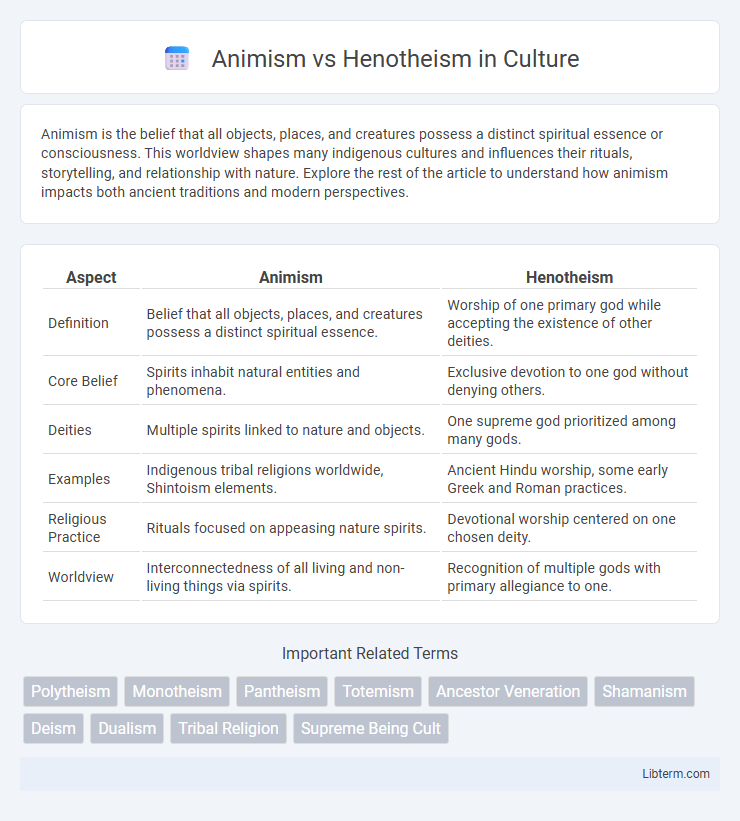Animism is the belief that all objects, places, and creatures possess a distinct spiritual essence or consciousness. This worldview shapes many indigenous cultures and influences their rituals, storytelling, and relationship with nature. Explore the rest of the article to understand how animism impacts both ancient traditions and modern perspectives.
Table of Comparison
| Aspect | Animism | Henotheism |
|---|---|---|
| Definition | Belief that all objects, places, and creatures possess a distinct spiritual essence. | Worship of one primary god while accepting the existence of other deities. |
| Core Belief | Spirits inhabit natural entities and phenomena. | Exclusive devotion to one god without denying others. |
| Deities | Multiple spirits linked to nature and objects. | One supreme god prioritized among many gods. |
| Examples | Indigenous tribal religions worldwide, Shintoism elements. | Ancient Hindu worship, some early Greek and Roman practices. |
| Religious Practice | Rituals focused on appeasing nature spirits. | Devotional worship centered on one chosen deity. |
| Worldview | Interconnectedness of all living and non-living things via spirits. | Recognition of multiple gods with primary allegiance to one. |
Introduction to Animism and Henotheism
Animism is a belief system that attributes spiritual essence to natural elements, animals, and objects, emphasizing a world inhabited by diverse spirits. Henotheism involves devotion to one primary deity while acknowledging the existence of other gods, blending monotheistic and polytheistic features. Both frameworks shape cultural perceptions of divinity and spirituality, influencing religious practices globally.
Defining Animism: Core Beliefs and Practices
Animism centers on the belief that all entities--living beings, objects, and natural phenomena--possess a distinct spiritual essence or soul, influencing human life and the environment. Core practices include rituals, offerings, and communication with spirits to maintain harmony and seek guidance. This worldview emphasizes interconnectedness between humans and nature, contrasting with henotheism, which worships one primary deity without denying others.
Understanding Henotheism: Meaning and Origins
Henotheism is the belief in and worship of one primary deity without denying the existence of other gods, contrasting with animism which attributes spiritual essence to all natural entities. Originating in ancient religious traditions, henotheism often served as a transitional phase between polytheism and monotheism, emphasizing the supremacy of a single god while acknowledging others. This concept is observed in texts like the Vedas, where a principal deity is honored above others, reflecting its deep roots in early Indo-Aryan spirituality.
Historical Development of Both Belief Systems
Animism, considered one of the oldest belief systems, originated in prehistoric times as humans attributed spiritual essence to animals, plants, and natural phenomena, deeply influencing tribal societies worldwide. Henotheism emerged later in ancient civilizations such as Mesopotamia and India, characterized by devotion to a single primary deity while acknowledging the existence of others, marking a transition from polytheistic to more centralized religious practices. The historical development of animism reflects a foundational spiritual worldview, whereas henotheism illustrates an intermediate stage toward monotheism in the evolution of organized religion.
Key Differences Between Animism and Henotheism
Animism centers on the belief that all objects, places, and creatures possess a distinct spiritual essence, emphasizing the presence of spirits in natural elements. Henotheism involves devotion to one primary deity while acknowledging the existence of other gods, often integrating worship practices within a broader pantheon. The key difference lies in animism's focus on spiritual life in natural phenomena, whereas henotheism prioritizes allegiance to a single god amid multiple divine beings.
Similarities and Overlapping Concepts
Animism and henotheism share the belief in the presence of spiritual forces influencing the natural world, with animism attributing spirits to objects, animals, and natural phenomena, while henotheism centers on worshiping one primary deity without denying others. Both systems acknowledge multiple spiritual entities, highlighting a layered cosmology where divine beings coexist and interact with humans. The overlapping concept of spiritual beings governing aspects of life creates a framework that blends reverence for nature with focused devotion on a supreme deity in henotheistic traditions.
Examples of Animism in Ancient and Modern Cultures
Animism is exemplified in ancient cultures such as the indigenous beliefs of Australian Aboriginal peoples, where natural elements like rivers and trees possess spirits, and in Shintoism of Japan, which continues to honor kami, spiritual essences within nature. Modern cultures practicing animism include various Indigenous groups in the Amazon rainforest who maintain a worldview connecting the spiritual essence to animals, plants, and landscape features. These beliefs contrast with henotheism, which centers on worshiping a single primary deity while not denying the existence of other gods.
Notable Henotheistic Traditions and Examples
Henotheism is characterized by the worship of one primary deity while acknowledging the existence of other gods, as seen in traditions like Hinduism, where deities such as Vishnu or Shiva are venerated as supreme in different sects. Ancient Egyptian religion also exemplifies henotheism through the elevation of gods like Amun or Ra during various historical periods. In contrast to animism's belief in spiritual essence pervading all objects, henotheistic traditions concentrate on a central god with a structured pantheon supporting religious practices.
Impact on Society and Cultural Practices
Animism shapes societies by fostering a deep connection with nature, promoting rituals that honor spirits in animals, plants, and natural elements, which influences sustainable environmental practices and communal harmony. Henotheism centers worship on one primary deity while acknowledging others, reinforcing social hierarchy and empowering religious institutions to consolidate political authority and cultural identity. Both belief systems profoundly affect moral codes, festivals, and community cohesion, reflecting their role in structuring human interaction with the sacred and the natural world.
Contemporary Relevance and Future Perspectives
Animism remains influential in contemporary indigenous cultures, emphasizing interconnectedness with nature and environmental stewardship, which aligns with current ecological concerns. Henotheism, evident in certain modern religious movements, allows for the worship of one supreme deity while acknowledging others, fostering theological flexibility and interfaith dialogue. Future perspectives suggest both beliefs could shape spiritual approaches toward sustainability and pluralism in increasingly globalized societies.
Animism Infographic

 libterm.com
libterm.com